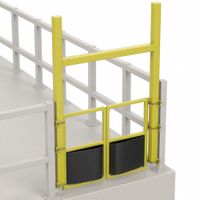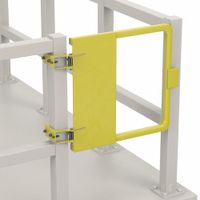Call +(254) 703 030 000 / 751 483 999 / 721 704 777
- Home
- Material Handling
- Ladders Platforms Personnel Lifts
- Elevated Safety Gates
.....Read More
Frequently Asked Questions
What are the benefits of installing elevated safety gates?
Elevated safety gates offer several benefits, enhancing safety and operational efficiency in various environments:
1. **Enhanced Safety**: Elevated safety gates provide a physical barrier that prevents accidental falls from elevated platforms, loading docks, or mezzanines. This is crucial in industrial settings where workers are frequently exposed to height-related risks.
2. **Compliance with Regulations**: Many industries are subject to strict safety regulations. Installing elevated safety gates helps businesses comply with OSHA and other safety standards, reducing the risk of legal penalties and ensuring a safe working environment.
3. **Increased Productivity**: By ensuring a safer work environment, elevated safety gates can reduce the number of workplace accidents. This leads to fewer disruptions, less downtime, and a more efficient workflow, ultimately boosting productivity.
4. **Versatility**: These gates can be used in various settings, including warehouses, construction sites, and manufacturing facilities. They are adaptable to different heights and widths, making them suitable for a wide range of applications.
5. **Durability and Longevity**: Made from robust materials like steel or aluminum, elevated safety gates are designed to withstand harsh industrial conditions. Their durability ensures a long service life, providing a cost-effective safety solution over time.
6. **Ease of Use**: Many elevated safety gates are designed for easy operation, with features like self-closing mechanisms or counterbalanced systems. This ensures that they can be used efficiently without hindering workflow.
7. **Improved Morale**: A safe working environment contributes to employee well-being and morale. Knowing that their safety is prioritized, workers are likely to feel more secure and satisfied, which can lead to better performance and reduced turnover.
8. **Customizable Options**: Elevated safety gates can be customized to fit specific needs, including color-coding for visibility, integration with existing safety systems, or additional features like alarms for enhanced security.
How do self-closing safety gates work?
Self-closing safety gates are designed to automatically close and latch after being opened, ensuring continuous protection without requiring manual intervention. They are commonly used in industrial, commercial, and residential settings to prevent unauthorized access or accidental entry into hazardous areas, such as stairwells, machinery zones, or elevated platforms.
The core mechanism of a self-closing safety gate involves a spring-loaded hinge or a hydraulic closer. When the gate is opened, the spring or hydraulic system stores energy. Once released, this stored energy is used to return the gate to its closed position. The speed and force of closure can often be adjusted to suit specific safety requirements, ensuring that the gate closes gently to avoid injury or damage.
In addition to the closing mechanism, self-closing safety gates are equipped with a latching system that secures the gate in the closed position. This latch can be a simple gravity latch, a magnetic catch, or a more complex locking mechanism, depending on the level of security needed. Some gates also feature a hold-open device that temporarily prevents the gate from closing, which can be useful during high-traffic periods.
Materials used for self-closing safety gates vary, including steel, aluminum, or high-strength polymers, chosen based on the environment and required durability. These gates are often coated with corrosion-resistant finishes for longevity, especially in outdoor or industrial settings.
Overall, self-closing safety gates provide a reliable, low-maintenance solution for maintaining safety and security, automatically ensuring that access points are closed and latched after each use.
What are the installation requirements for safety gates on mezzanines?
The installation requirements for safety gates on mezzanines typically include the following:
1. **Compliance with Regulations**: Ensure the safety gates meet OSHA standards or other relevant local safety regulations. This includes proper height, strength, and design to prevent falls.
2. **Material and Construction**: Use durable materials such as steel or aluminum that can withstand the environmental conditions and the weight of potential impacts. The construction should be robust to ensure longevity and safety.
3. **Gate Design**: Choose a design that suits the mezzanine's use. Options include swing gates, sliding gates, or lift-out gates. The design should allow for easy operation while maintaining safety.
4. **Height and Width**: The gate should be at least 42 inches high, with mid-rails and toe boards to prevent objects from falling. The width should accommodate the largest load that will pass through.
5. **Self-Closing Mechanism**: Install gates with a self-closing mechanism to ensure they return to a closed position after use, minimizing the risk of accidental openings.
6. **Clear Signage**: Place clear, visible signage on or near the gate to indicate its purpose and any operational instructions or warnings.
7. **Secure Mounting**: Ensure the gate is securely mounted to the mezzanine structure. Use appropriate hardware and anchoring systems to prevent detachment or failure.
8. **Regular Maintenance**: Establish a maintenance schedule to inspect and repair any wear or damage to the gate, ensuring it remains functional and safe.
9. **Training**: Provide training for employees on the proper use and importance of the safety gates to ensure compliance and safety awareness.
10. **Emergency Access**: Ensure that the gate design allows for quick and easy access in case of emergencies, without compromising safety.
How do I choose the right safety gate for my facility?
To choose the right safety gate for your facility, consider the following factors:
1. **Purpose and Functionality**: Determine the primary purpose of the gate—whether it's for fall protection, access control, or machinery guarding. This will guide the type of gate needed.
2. **Location and Environment**: Assess where the gate will be installed. Indoor or outdoor locations may require different materials due to exposure to elements like moisture or chemicals. Consider environmental factors such as temperature, humidity, and potential exposure to corrosive substances.
3. **Material and Durability**: Choose materials that match the environmental conditions and expected wear and tear. Common materials include steel, aluminum, and plastic, each offering different levels of durability and corrosion resistance.
4. **Size and Dimensions**: Measure the area where the gate will be installed to ensure it fits properly. Consider the height, width, and any clearance requirements.
5. **Compliance and Standards**: Ensure the gate meets relevant safety standards and regulations, such as OSHA or ANSI, to ensure legal compliance and safety.
6. **Ease of Use and Installation**: Consider gates that are easy to install and operate. Features like self-closing mechanisms or adjustable sizes can enhance usability.
7. **Security Features**: If security is a concern, look for gates with locking mechanisms or integration with access control systems.
8. **Cost and Budget**: Balance the cost with the features and durability required. While budget constraints are important, prioritize safety and compliance.
9. **Vendor Reputation and Support**: Choose a reputable supplier known for quality products and good customer support. Check reviews and ask for references if necessary.
10. **Maintenance Requirements**: Consider the maintenance needs of the gate to ensure long-term functionality and safety.
By evaluating these factors, you can select a safety gate that effectively meets the needs of your facility.
Are there specific regulations or standards for safety gate installations?
Yes, there are specific regulations and standards for safety gate installations to ensure the safety and well-being of individuals, particularly children. These regulations vary by country but generally include the following key points:
1. **ASTM Standards (U.S.):** The American Society for Testing and Materials (ASTM) has established standards such as ASTM F1004, which outlines the safety specifications for expansion gates and expandable enclosures. These standards address aspects like the strength of the gate, the size of openings to prevent entrapment, and the materials used.
2. **EN Standards (Europe):** In Europe, the EN 1930 standard specifies the safety requirements and test methods for child safety barriers. This includes guidelines on the height of the gate, the spacing of bars, and the locking mechanisms to prevent children from opening the gate.
3. **CPSC Guidelines (U.S.):** The Consumer Product Safety Commission (CPSC) provides guidelines and recalls for safety gates that do not meet safety standards. They focus on preventing hazards such as entrapment, falls, and choking.
4. **Installation Instructions:** Manufacturers are required to provide clear installation instructions to ensure that gates are installed correctly. This includes guidance on the appropriate locations for installation, such as the top or bottom of stairs, and the correct use of hardware.
5. **Labeling Requirements:** Safety gates must have proper labeling, including warnings about potential hazards, age recommendations, and instructions for use.
6. **Regular Inspections:** It is recommended that safety gates be regularly inspected for wear and tear, ensuring that they remain secure and functional over time.
These regulations and standards are designed to minimize risks and ensure that safety gates provide effective protection in homes and other environments where children are present.
How often should safety gates be inspected and maintained?
Safety gates should be inspected and maintained regularly to ensure they function correctly and provide the necessary protection. The frequency of inspections and maintenance can vary based on several factors, including the environment in which the gates are used, the manufacturer's recommendations, and regulatory requirements. However, a general guideline is as follows:
1. **Daily Visual Inspections**: Conduct a quick visual check daily to ensure there are no obvious signs of damage or malfunction. This includes checking for any physical damage, ensuring the gate closes and latches properly, and verifying that there are no obstructions.
2. **Monthly Functional Checks**: Perform a more thorough inspection at least once a month. This should include testing the gate's operation, checking the condition of hinges, latches, and any locking mechanisms, and ensuring that all components are secure and in good working order.
3. **Quarterly Maintenance**: Every three months, conduct a detailed maintenance check. This should involve lubricating moving parts, tightening any loose bolts or screws, and replacing any worn or damaged components. It's also a good time to review the gate's alignment and adjust as necessary.
4. **Annual Professional Inspection**: At least once a year, have a professional or a qualified technician perform a comprehensive inspection and maintenance service. This ensures that any potential issues are identified and addressed by someone with expertise in safety gate systems.
5. **After Any Incident**: If the gate is involved in an incident or shows signs of malfunction, it should be inspected and repaired immediately, regardless of the regular schedule.
Adhering to these guidelines helps maintain the safety and reliability of safety gates, ensuring they provide effective protection at all times.
Can safety gates be customized for specific applications?
Yes, safety gates can be customized for specific applications. Customization is often necessary to meet the unique requirements of different environments, industries, and safety standards. Here are some ways safety gates can be tailored:
1. **Material Selection**: Depending on the environment, materials like stainless steel, aluminum, or plastic can be chosen for corrosion resistance, durability, or lightweight properties.
2. **Size and Dimensions**: Gates can be manufactured to fit specific openings, ensuring a perfect fit for the area they are intended to secure.
3. **Design and Configuration**: The design can be adjusted to include features like self-closing mechanisms, adjustable widths, or specific locking systems to enhance safety and usability.
4. **Color and Finish**: Custom colors or finishes can be applied to meet visibility requirements or to match the aesthetic of the surrounding area.
5. **Mounting Options**: Different mounting options, such as wall-mounted, floor-mounted, or portable gates, can be selected based on the installation site.
6. **Safety Features**: Additional safety features like alarms, sensors, or signage can be integrated to provide enhanced protection and awareness.
7. **Compliance with Standards**: Customization can ensure that the gates meet specific industry standards or regulations, such as OSHA or ANSI, which may vary depending on the application.
8. **Environmental Considerations**: For outdoor or harsh environments, gates can be designed to withstand extreme temperatures, moisture, or chemical exposure.
By customizing safety gates, businesses can ensure that they not only meet safety requirements but also enhance operational efficiency and worker protection in their specific application.

